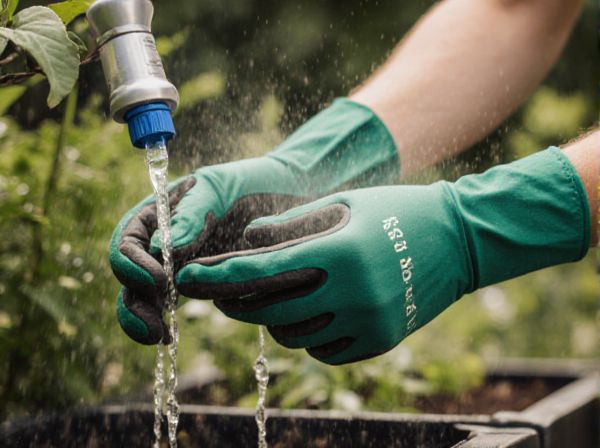
Reverse Osmosis Water vs Tap Water Illustration
Reverse osmosis water offers superior purity by removing contaminants and minerals compared to tap water, making it ideal for hydroponic systems that require precise nutrient control. Tap water may contain chlorine, chloramines, and heavy metals that can harm plant roots and disrupt nutrient absorption. Using reverse osmosis water ensures optimal plant growth and prevents build-up of harmful residues in hydroponic reservoirs.
Table of Comparison
| Feature | Reverse Osmosis Water | Tap Water |
|---|---|---|
| Purity | High purity; removes 95-99% impurities and minerals | Depends on source; contains chlorine, minerals, and possible contaminants |
| Mineral Content | Very low; often requires remineralization for hydroponics | Contains natural minerals beneficial for plants |
| pH Level | Neutral to slightly acidic (5.0-7.0) | Varies widely; often alkaline (7.0-8.5) |
| Contaminants | Virtually free of chlorine, heavy metals, and pathogens | May contain chlorine, chloramine, heavy metals, and microbes |
| Cost | Higher; requires RO system installation and maintenance | Low; readily available without additional cost |
| Effect on Plant Growth | Consistent nutrient uptake; better control over nutrient solutions | Variable; risk of toxicity or nutrient imbalance |
Introduction to Water Quality in Hydroponic Gardening
Reverse osmosis water offers high purity by removing impurities, salts, and contaminants, making it ideal for hydroponic gardening where precise nutrient control is essential. Tap water quality varies widely depending on location, often containing chlorine, chloramines, minerals, and other chemicals that can affect plant growth and nutrient uptake. Understanding water quality parameters such as pH, total dissolved solids (TDS), and hardness is crucial for optimizing nutrient solutions and ensuring healthy hydroponic crop development.
Understanding Reverse Osmosis Water
Reverse osmosis water is purified by forcing tap water through a semi-permeable membrane, effectively removing contaminants like chlorine, heavy metals, and dissolved salts, making it ideal for hydroponic systems. This clean water source ensures precise nutrient delivery and reduces the risk of pathogen buildup, promoting healthier plant growth compared to untreated tap water. Understanding reverse osmosis water quality is crucial for maintaining optimal pH levels and nutrient balance in hydroponic setups.
Characteristics of Tap Water for Hydroponics
Tap water used in hydroponics often contains chlorine, chloramine, and varying levels of dissolved minerals like calcium, magnesium, and iron that can impact nutrient availability and pH balance. It typically has a higher total dissolved solids (TDS) content compared to reverse osmosis water, which may lead to nutrient lockout or toxicity if not properly managed. Monitoring and adjusting the pH and mineral concentration in tap water is essential to maintain optimal hydroponic growth conditions.
Key Differences: RO Water vs Tap Water
Reverse osmosis (RO) water undergoes a filtration process that removes impurities, minerals, and contaminants, resulting in highly purified water ideal for hydroponic systems where nutrient control is critical. Tap water contains varying levels of minerals, chlorine, and possible contaminants that can affect plant growth and nutrient absorption, potentially leading to imbalances in a hydroponic setup. Using RO water allows for more precise nutrient formulation and reduces the risk of harmful substances interfering with the plant's development.
Benefits of Using Reverse Osmosis Water in Hydroponics
Reverse osmosis water enhances hydroponic systems by providing purified water free from contaminants such as chlorine, heavy metals, and dissolved solids that can hinder nutrient absorption and plant growth. Using reverse osmosis water improves nutrient availability and promotes healthier root development, resulting in higher yields and stronger plants. Its consistent purity also reduces the risk of disease and buildup of harmful residues in the hydroponic solution, optimizing overall system longevity and efficiency.
Common Issues with Tap Water in Hydroponic Systems
Tap water in hydroponic systems often contains chlorine, chloramine, heavy metals, and high levels of salts that can harm plant roots and disrupt nutrient absorption. These contaminants may lead to nutrient imbalances, root burn, and microbial growth, negatively impacting plant health and yield. Using reverse osmosis water eliminates most impurities, providing a clean and stable water source essential for optimal hydroponic growth.
Impact on Plant Growth and Nutrient Absorption
Reverse osmosis water provides a highly purified medium that removes contaminants and excess minerals, optimizing nutrient uptake and overall plant growth in hydroponic systems. Tap water often contains chlorine, chloramines, and varying mineral content which can negatively affect root health and nutrient absorption efficiency. Using reverse osmosis water allows for precise control over nutrient concentration, leading to more consistent plant development and higher yields.
Cost Analysis: RO Systems vs Using Tap Water
Reverse osmosis (RO) systems for hydroponic setups typically involve higher initial costs, often ranging from $150 to $500, along with ongoing expenses for filter replacements every 6 to 12 months, averaging $30 to $100 annually. Tap water, while readily available and low-cost, may require additional treatment such as pH balancing and removal of chlorine or chloramines, which can incur extra expenses but generally remain lower than RO maintenance. Over time, RO water tends to provide more consistent nutrient absorption and plant growth, potentially offsetting the higher upfront investment through improved crop yield and quality.
Maintenance and Practical Considerations for Water Choice
Reverse osmosis water requires less frequent maintenance in hydroponic systems due to its purity, which reduces mineral buildup and clogging in pumps and tubing. Tap water often contains chlorine, chloramine, and varying mineral content that necessitate additional filtration or treatment, increasing routine system upkeep. Selecting reverse osmosis water enhances consistent nutrient delivery and prolongs equipment lifespan, optimizing overall system performance.
Choosing the Best Water Source for Hydroponic Success
Reverse osmosis water provides a highly purified, mineral-free solution ideal for precise nutrient control in hydroponic systems, ensuring optimal plant growth and preventing unwanted contaminants. Tap water often contains chlorine, chloramines, and varying mineral content, which can disrupt nutrient balance and harm sensitive hydroponic crops. Selecting reverse osmosis water over tap water enhances water quality consistency and supports healthier root development, maximizing hydroponic yield and crop quality.
Reverse Osmosis Water vs Tap Water Infographic

 gardendif.com
gardendif.com